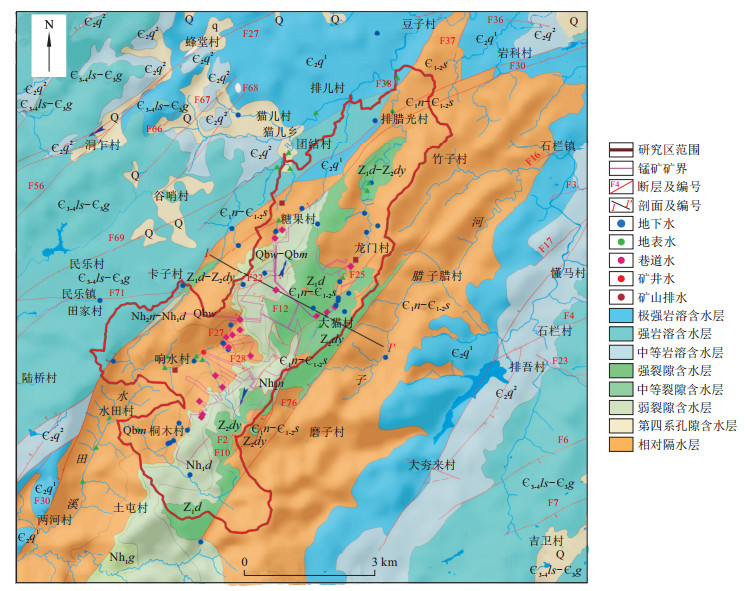Identification of the sources of old kiln water and the causes of water pollution in the historical manganese mine
-
摘要:
历史遗留矿山的老窑水防治是矿山水环境治理中的难点。选取中国锰三角地区的典型锰矿区为研究对象,以查明老窑水的来源及水体污染成因。综合利用矿山水文地质调查、气象水文分析、水化学与同位素溯源等技术方法对老窑水来源和特征污染物进行了识别,并分析了矿区的水体污染成因模式。结果表明:研究区老窑水动态对降雨响应灵敏,老窑水主要来源于巷道和优势径流通道汇集的大气降水和含水层中的地下水;矿区矿井水、巷道水中的特征污染物为硫酸锰,矿山排水的特征污染物为硫酸钠,硫酸锰主要由硫铁矿氧化和菱锰矿溶解而形成;矿山固体废弃物淋滤入渗和老窑水的混合是区内地下水的主要污染方式,而地表水主要受矿山固体废弃物淋滤汇流、巷道口排水和矿山排水的污染。研究成果为矿山水环境治理提供了水量形成和水质演化的科学依据。
Abstract:The prevention and control of old kiln water in historical mines is a challenging problem in mine water management. In this paper, the typical manganese mining area in the manganese triangle area of China is selected as a case study.
Objective In order to identify the sources of old kiln water and the causes of water pollution,
Methods the technical approaches such as mine hydrogeological survey, hydrological analysis, hydrochemistry and isotope tracing are used to identify the source and characteristic pollution of old kiln water, and the causes of water pollution in the mining area is analyzed.
Results Results show that, the hydrological response of old kiln water in the study is sensitive to rainfall events. The old kiln water mainly comes from the rainfall collected by the roadway, dominant runoff channel and groundwater in the aquifer. The characteristic pollutants of mine water and roadway water are manganese and sulfate, and the characteristic pollutants of mine drainage are sodium and sulfate. Manganese and sulfate are mainly formed by the oxidation of pyrite and the dissolution of rhodochrosite. The leaching and infiltration of mine solid waste and the mixing of old kiln water are main causes of groundwater pollution, while the surface water is mainly affected by pollution of leaching and confluence from mine solid waste, roadway drainage and mine drainage.
Conclusion The research results of this paper provide a scientific basis for water quantity formation and water quality evolution for mine water environment management.
-
Key words:
- manganese mine /
- old kiln water /
- source identification /
- pollution cause /
- water pollutioin
-
-
[1] 武强, 董书宁, 张志龙. 矿井水害防治[M]. 江苏徐州: 中国矿业大学出版社, 2007.WU Q, DONG S N, ZHANG Z L. Mine water disaster prevention and control[M]. Xuzhou Jiangsu: China University of Mining & Technology Press, 2007. (in Chinese) [2] WANG Y, MA T, LUO Z. Geostatistical and geochemical analysis of surface water leakage into groundwater on a regional scale: A case study in the Liulin karst system, northwestern China[J]. Journal of Hydrology, 2001, 246(1/2/3/4): 223-234. [3] 黄荷, 陈植华, 王涛, 等. 岩溶矿区水文地球化学特征及其水源指示意义[J]. 水文地质工程地质, 2019, 46(1): 19-26.HUANG H, CHEN Z H, WANG T, et al. Groundwater source identification incarbonate-hosted deposit using hydrogeochemistry, hydrogen and oxygen isotope method[J]. Hydrogeology & Engineering Geology, 2019, 46(1): 19-26. (in Chinese with English abstract) [4] 马超, 曾斌, 罗明明, 等. 武汉两湖隧道岩溶水系统结构及水循环规律[J]. 地质科技通报, 2022, 41(5): 395-404. doi: 10.19509/j.cnki.dzkq.2022.0198MA C, ZENG B, LUO M M, et al. Structure of karst water system and hydrological circulation characteristics of Lianghu Tunnel in Wuhan[J]. Bulletin of Geological Science and Technology, 2022, 41(5): 395-404. (in Chinese with English abstract) doi: 10.19509/j.cnki.dzkq.2022.0198 [5] 廖启鹏, 陈茹, 黄士真. 基于模糊综合评判与GIS方法的废弃矿区景观评价[J]. 地质科技情报, 2019, 38(6): 241-250.LIAO Q P, CHEN R, HUANG S Z. Study on landscape evaluation of abandoned mining area based on fuzzy comprehensive evaluation and GIS[J]. Geological Science and Technology Information, 2019, 38(6): 241-250. (in Chinese with English abstract) [6] 袁慧卿. 姚桥煤矿主要充水含水层水化学特征及水源判别方法研究[D]. 江苏徐州: 中国矿业大学, 2021.YUAN H Q. Study on the hydrochemical characteristics and water source discrimination method of the main water-filled aquifers in Yaoqiao Coalmine[D]. Xuzhou Jiangsu: China University of Mining and Technology, 2021. (in Chinese with English abstract) [7] ZHANG Z H, XIAO C L, ADEYEYE O, et al. Source and mobilization mechanism of iron, manganese and arsenic in groundwater of Shuangliao City, Northeast China[J]. Water, 2020, 12(2): 534. doi: 10.3390/w12020534 [8] 孙龙, 刘廷玺, 段利民, 等. 矿区流域不同水体同位素时空特征及水循环指示意义[J]. 水科学进展, 2022, 33(5): 805-815.SUN L, LIU T X, DUAN L M, et al. Spatial and temporal characteristics of isotopes of different water sources and implications for water circulation in mining areas[J]. Advances in Water Science, 2022, 33(5): 805-815. (in Chinese with English abstract) [9] 周祥, 钱静. 江西省靖安县大雾塘矿区矿床充水因素分析[J]. 世界有色金属, 2017(19): 217-218.ZHOU X, QIAN J. Analysis of water charge factor for the mineral deposits in Dawutang of Jing'an County, Jiangxi Province[J]. World Nonferrous Metals, 2017(19): 217-218. (in Chinese with English abstract) [10] 谢红东. 织金矿区矿井充水因素及涌水量预测研究[J]. 世界有色金属, 2020(12): 181-183.XIE H D. Research on water-filling factors and water inflow prediction of Yingjiao Coal Mine in Zhijin mining area[J]. World Nonferrous Metals, 2020(12): 181-183. (in Chinese with English abstract) [11] 李琬钰, 周建伟, 贾晓岑, 等. 湖南锡矿山锑矿区水环境中DOM三维荧光特征及其对锑污染的指示意义[J]. 地质科技通报, 2022, 41(4): 215-224. doi: 10.19509/j.cnki.dzkq.2022.0119LI W Y, ZHOU J W, JIA X C, et al. EEMs characteristics of dissolved organic matter in water environment and its implications for antimony contamination in antimony mine of Xikuangshan, Hunan Province[J]. Bulletin of Geological Science and Technology, 2022, 41(4): 215-224. (in Chinese with English abstract) doi: 10.19509/j.cnki.dzkq.2022.0119 [12] NASSERY H R, ALIJANI F. The effects of an abandoned coal mine on groundwater quality in the science and research park(SRP) of Shahid Beheshti University, Zirab(northern Iran)[J]. Mine Water and the Environment, 2014, 33(3): 266-275. [13] ZHANG Y, REN B Z, HURSTHOUSE A S, et al. An improved SWAT for predicting manganese pollution load at the soil-water interface in a manganese mine area[J]. Polish Journal of Environmental Studies, 2018, 27(5): 2357-2365. [14] PRASAD B, MAITI D, SINGH K K K. Impact of fly ash placement in an abandoned opencast mine on surface and ground water quality: A case study[J]. Mine Water and the Environment, 2019, 38(1): 72-80. [15] 谢李娜, 周建伟, 郝春明, 等. 湘中锡矿山北矿区地下水化学特征及污染成因[J]. 地质科技情报, 2016, 35(2): 197-202.XIE L N, ZHOU J W, HAO C M, et al. Hydrochemical characteristics and contaminative causes of groundwater in the north area of Xikuangshan Antimony Mine, Hunan Province[J]. Geological Science and Technology Information, 2016, 35(2): 197-202. (in Chinese with English abstract) [16] RÖSNER U. Effects of historical mining activities on surface water and groundwater: An example from northwest Arizona[J]. Environmental Geology, 1998, 33(4): 224-230. [17] WRIGHT I A, PACIUSZKIEWICZ K, BELMER N. Increased water pollution after closure of Australia's longest operating underground coal mine: A 13-month study of mine drainage, water chemistry and river ecology[J]. Water, Air, & Soil Pollution, 2018, 229(3): 55. [18] LIU Z, KUANG Y, LAN S T, et al. Pollution distribution of potentially toxic elements in a karstic river affected by manganese mining in Changyang, western Hubei, central China[J]. International Journal of Environmental Research and Public Health, 2021, 18(4): 1870. [19] 常昕, 章新平, 刘仲藜, 等. 长沙降水中稳定同位素的昼夜差别[J]. 热带地理, 2021, 41(3): 635-644.CHANG X, ZHANG X P, LIU Z L, et al. Differences in stable isotopes in precipitation between day and night: A case study of Changsha[J]. Tropical Geography, 2021, 41(3): 635-644. (in Chinese with English abstract) [20] KHOZYEM H, HAMDAN A, TANTAWY A A, et al. Distribution and origin of iron and manganese in groundwater: Case study, Balat-Teneida area, El-Dakhla Basin, Egypt[J]. Arabian Journal of Geosciences, 2019, 12(16): 523. [21] 周立同, 刘邦定, 谭仕敏. 湖南花垣地区大塘坡式锰矿成矿地质条件及裂谷盆地研究[J]. 中国资源综合利用, 2021, 39(3): 98-100.ZHOU L T, LIU B D, TAN S M. Research on metallogenic geological conditions and rift basin of datangpo-type manganese deposit in Huayuan area, Hunan[J]. China Resources Comprehensive Utilization, 2021, 39(3): 98-100. (in Chinese with English abstract) [22] 赖嘉进, 吴世芳, 熊楚宏, 等. 湖南省花垣县民乐矿区锰矿详细勘探地质报告[R]. 湖南吉首: 湖南省地质局四○五队, 1982: 36.LAN J J, WU S F, XIONG C H, et al. Detailed exploration geological report of manganese ore in Minle Mining area, Huayuan County, Hunan Province[R]. Jishou, Hunan: The 405 Geological Team of Hunan Geological Bureau, 1982: 36. (in Chinese) -





 下载:
下载:












